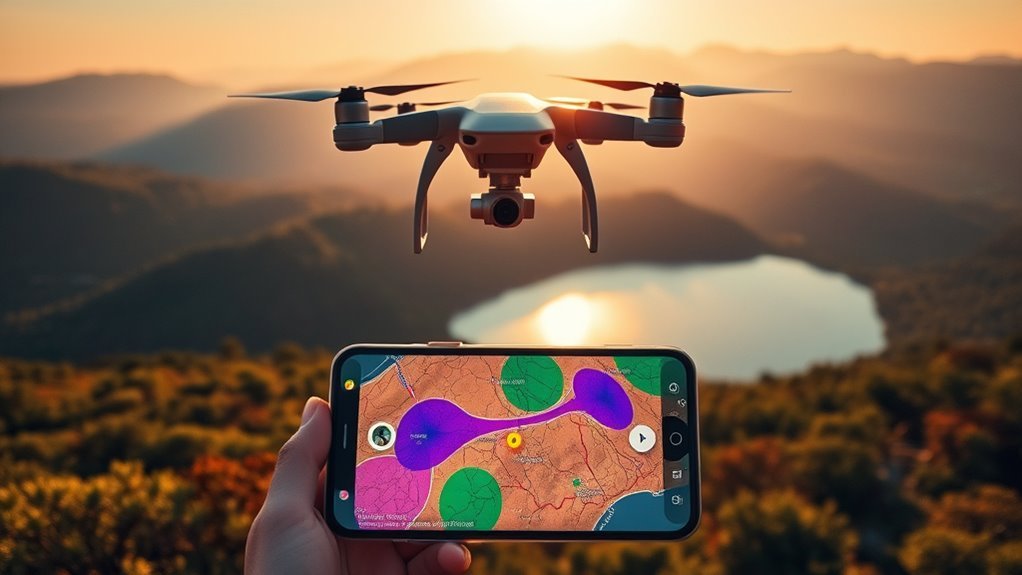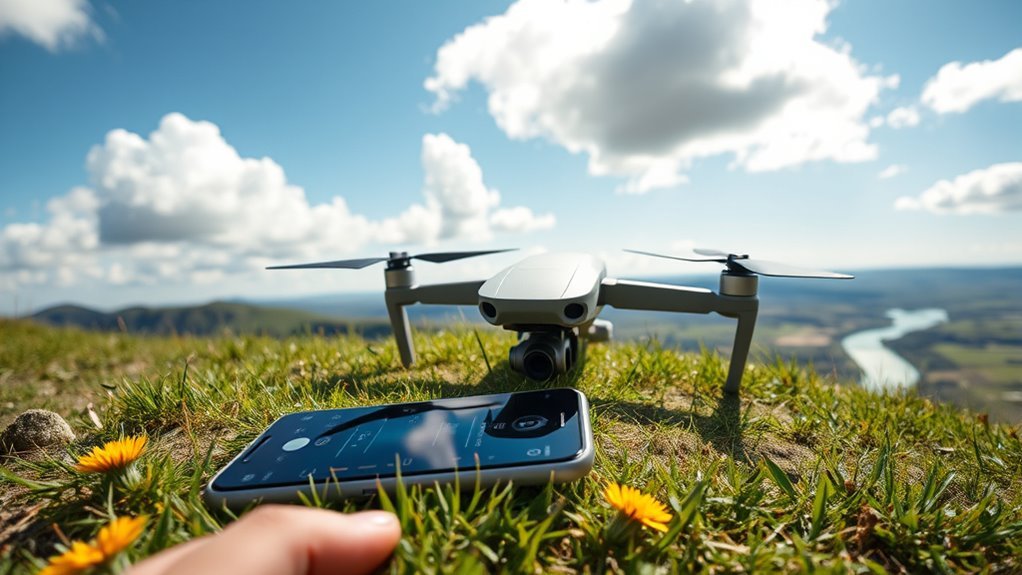To track your drone, start by choosing the right GPS-based or RF tracking device based on your operational needs. Install and set up your drone’s GPS module, ensuring you test it outdoors for peak accuracy. Use smartphone apps for real-time tracking and geofencing alerts that suit your drone model. Consider preventative measures to avoid future mishaps, such as a pre-flight checklist. Continue exploring for detailed tactics and techniques to enhance your tracking capabilities.
Understanding Drone Tracking Basics
Understanding the basics of drone tracking is essential for anyone looking to enhance their aerial operations. Drone tracking technology enables real-time location monitoring, ensuring you can always locate your craft. When diving into tracking system comparison, you’ll discover various options, each with unique features and benefits. GPS-based systems are popular for their accuracy, while RF systems offer extended range, making them ideal for long-distance flights. In contrast, cellular tracking systems leverage existing networks, providing coverage in remote areas. Familiarizing yourself with these technologies allows you to make informed decisions, maximizing the efficiency and safety of your operations. Ultimately, the right choice empowers you, giving you the freedom to explore the skies with confidence and precision.
Choosing the Right Tracking Device
When selecting a tracking device for your drone, it’s essential to take into account your specific operational needs and the environments in which you’ll be flying. There are various tracking device types, such as GPS-based systems, RF trackers, and cellular devices, each offering unique benefits. For instance, GPS devices provide global coverage, while RF trackers excel in remote areas. Make certain that the tracking device you choose is compatible with your drone model, as not all systems work seamlessly with every unit. Consider factors like battery life, range, and additional features like geofencing. By understanding your requirements and choosing the right device, you’ll enhance your drone’s operational freedom and minimize the risk of losing it during flights. Additionally, being aware of local regulations regarding drone tracking can further ensure compliance and safety during your operations.
Setting Up Your Drone’s GPS

To set up your drone’s GPS effectively, start by choosing the right GPS module that meets your specific needs. Once you’ve selected a GPS, configure the necessary settings to guarantee accurate tracking performance. Finally, test the GPS functionality to confirm it’s working properly before you take to the skies.
Choosing the Right GPS
Selecting the right GPS for your drone is crucial for guaranteeing accurate tracking and navigation during flights. Look for a GPS that boasts high GPS accuracy, as this will directly impact your drone’s ability to maintain its position and navigate effectively. Consider models that offer advanced GPS features, such as real-time updates and geofencing capabilities. These features not only enhance your flying experience but also provide added safety by preventing your drone from straying into restricted areas. Additionally, evaluate the GPS’s integration with your drone’s onboard systems to guarantee seamless functionality. Prioritizing these factors will empower you to explore the skies with confidence, knowing your drone’s navigation is reliable and precise.
Configuring GPS Settings
Before taking your drone into the air, configuring the GPS settings is essential for best performance. Start by accessing the drone’s app or onboard settings. Here, you’ll find GPS configuration options that allow you to adjust parameters like satellite preferences and signal strength. For optimal performance, make sure your drone is outdoors with a clear view of the sky—this helps in optimizing signal reception. Consider enabling features like ‘Return to Home,’ which can automatically guide your drone back to its starting point if the signal is lost. Finally, follow GPS configuration tips from your manufacturer’s manual for specific adjustments unique to your model. A well-configured GPS will enhance your flying experience and make certain your drone stays safely within your control.
Testing GPS Functionality
Once you’ve configured your drone’s GPS settings, it’s crucial to test its functionality to make certain everything operates smoothly. Start by powering on your drone and ensuring it can connect to satellite signals. Look for a strong GPS lock, which indicates good GPS accuracy. You can verify this by checking your drone’s display for the number of satellites it’s connected to; ideally, you want at least six for peak performance. Next, perform a short flight to assess how well the GPS holds its position. Observe if the drone maintains a stable hover and responds accurately to your commands. If you notice any drift or unresponsiveness, you may need to recalibrate the GPS settings for improved accuracy and reliability in future flights.
Using Smartphone Apps for Tracking
While many drone enthusiasts rely on traditional tracking methods, using smartphone apps has become an increasingly popular and efficient way to monitor your drone’s location in real-time. These apps often offer smartphone compatibility with various devices, ensuring you can access tracking features whether you’re using an Android or iOS device. Key app features typically include live GPS tracking, geofencing alerts, and telemetry data, which provide essential information about your drone’s flight status. By integrating your smartphone with the drone’s system, you can easily receive updates and notifications, enhancing your flying experience. Before choosing an app, make sure to check its compatibility with your drone model and explore the features that best meet your tracking needs.
Implementing Visual Tracking Techniques
Implementing visual tracking techniques can greatly enhance your ability to monitor your drone during flight. By using visual tracking methods, you can maintain situational awareness and guarantee your drone stays within your line of sight. Employing drone tracking software in conjunction with these methods allows you to overlay visual cues on your display, helping you quickly identify the drone’s location and orientation. Techniques like using contrasting colors, unique markers, or even augmented reality can considerably improve your tracking capabilities. Additionally, consider establishing a visual reference point, such as a landmark, to assist in tracking. By integrating these visual techniques with your drone tracking software, you’ll enjoy a more seamless flying experience, allowing you the freedom to explore without losing sight of your device. Furthermore, leveraging advanced data encryption ensures that the information about your drone’s location remains secure during transmission. In addition, being aware of signal strength can significantly impact how effectively you track your drone in various environments.
What to Do If Your Drone Goes Missing
If your drone goes missing, it’s essential to act quickly to increase the chances of recovery. Start by utilizing your drone’s GPS tracking system, if available. This can provide a last-known location to focus your search efforts. Implement drone search strategies such as retracing your flight path and checking areas with good visibility. Enlist the help of local drone communities or online forums; they might have valuable insights or be willing to assist in the search. Utilize social media to spread the word—sharing information about your missing drone can generate leads. Additionally, keep in mind to check your drone’s last known location to narrow down your search area effectively. If you’re unable to locate it, consider contacting local authorities for assistance in missing drone recovery, as they can help you navigate legal boundaries surrounding drone operations. Staying organized and proactive is key in these situations.
Preventative Measures for Future Flights
Before each flight, it’s vital to complete a pre-flight checklist to guarantee your drone is in peak condition. Additionally, checking GPS signal strength can help prevent loss of control during your flight. These steps are essential for enhancing safety and reliability in your drone operations. Furthermore, understanding battery types can play a crucial role in ensuring your drone lasts longer in the air, as different batteries have varying impacts on flight duration. Implementing advanced algorithms for payload management can significantly enhance your drone’s stability and control, especially when carrying heavier loads.
Pre-Flight Checklist
A thorough pre-flight checklist is essential for guaranteeing the safety and efficiency of your drone operations. By following these steps, you can enhance your pre-flight safety and maintain your drone’s performance:
- Inspect the drone: Check for any physical damage, verifying all components are secure.
- Battery check: Confirm your battery is fully charged and properly connected to prevent mid-flight failures.
- Calibration: Calibrate the compass and IMU to guarantee accurate flight paths.
- Software updates: Make sure your drone’s firmware is up-to-date for peak performance and safety features.
Implementing this checklist not only promotes drone maintenance but also empowers you to fly with confidence, allowing you to embrace the freedom of the skies while minimizing risks.
GPS Signal Strength
Ensuring strong GPS signal strength is essential for maintaining control and stability during your drone flights. To mitigate gps interference sources, consider the following preventative measures. Utilizing signal amplification techniques can enhance your GPS reliability, allowing for smoother operation and reduced risk of signal loss. Be aware of common interference sources, such as tall buildings, trees, and weather conditions.
| Interference Source | Preventative Measure |
|---|---|
| Tall Buildings | Choose open flight areas |
| Trees | Fly at higher altitudes |
| Weather Conditions | Check forecasts before flying |
| Electronic Devices | Maintain distance from devices |
Frequently Asked Questions
Can Drones Be Tracked Without GPS Technology?
Yes, drones can be tracked without GPS technology. You might explore drone detection methods like RF signal analysis or visual tracking. Alternative tracking solutions include using radar or infrared sensors for enhanced situational awareness and control.
What Is the Average Range of Drone Tracking Devices?
The average range of drone tracking devices varies, but many utilize drone technology within 1 to 10 kilometers. Tracking accuracy can depend on environmental factors, so ideal conditions enhance performance and reliability for your flights.
Are Tracking Devices Compatible With All Drone Models?
Not all tracking devices are compatible with every drone model. You’ll encounter compatibility concerns and device limitations, so it’s vital to verify specifications before purchasing to guarantee seamless integration and maintain your freedom in piloting.
How Can I Enhance My Drone’s Signal Strength?
You’d think your drone’s signal is invincible, right? To enhance it, consider installing signal boosters or antenna upgrades. These tweaks can greatly improve your range, giving you the freedom to soar even higher.
Do Tracking Devices Require a Subscription Service?
Yes, tracking devices often require subscription costs for advanced features. These subscriptions typically provide real-time tracking, alerts, and geofencing. Evaluate your needs to determine if the benefits justify the ongoing expense for your drone’s freedom.

